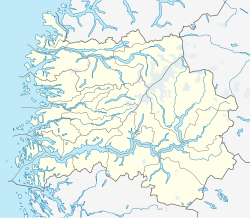Midtgulen Church
| Midtgulen Church | |
|---|---|
| Midtgulen kyrkje | |

View of the church
|
|
| 61°44′25″N 5°09′47″E / 61.7403°N 5.1631°ECoordinates: 61°44′25″N 5°09′47″E / 61.7403°N 5.1631°E | |
| Location |
Bremanger Municipality, Sogn og Fjordane |
| Country | Norway |
| Denomination | Church of Norway |
| Churchmanship | Evangelical Lutheran |
| Website | Midtgulen Church |
| History | |
| Consecrated | 3 May 1904 |
| Architecture | |
| Status | Parish church |
| Functional status | Active |
| Architect(s) | Lars Sølvberg |
| Style | Langkyrkje ("Long church") |
| Completed | 1904 |
| Specifications | |
| Materials | Wood |
| Administration | |
| Parish | Midtgulen |
| Deanery | Nordfjord prosti |
| Diocese | Diocese of Bjørgvin |
Midtgulen Church (Norwegian: Midtgulen kyrkje) is a parish church in Bremanger Municipality in Sogn og Fjordane county, Norway. It is located in the village of Midtgulen, along the shore of the Gulen fjord. The church is part of the Midtgulen parish in the Nordfjord deanery in the Diocese of Bjørgvin. The church, with a seating capacity of 200, was consecrated on 3 May 1904, by the Bishop Johan Willoch Erichsen. The architect Lars Sølvberg from Utvik made the designs. It is a wooden church of the "long church" design.
The old municipality of Bremanger comprised some areas around the Gulen fjord, while the majority of people lived on the island of Bremangerlandet where the parish church was located. The local people of Midtgulen promoted the church issue more in the form of a wish rather than a demand, and they discussed the matter more among themselves than with the vicar.
The first vicar in the parish, Ulrik Koren, was not particularly enthusiastic about building a church at Mudtgulen, as this would imply crossing the Frøysjøen strait in all kinds of weather. The vicar on his part took no initiative to build more churches in the parish. A new church was built on the island of Frøya in the 1860s, moving the parish church to a more central location.
When the people of Gulen got an auxiliary graveyard in 1879, this was a step closer to getting their own church. In the early 1890s, the matter was formally put on the agenda for the local council. There was no discussion whatsoever concerning the location of the new church; it had to be next to the graveyard.
...
Wikipedia


